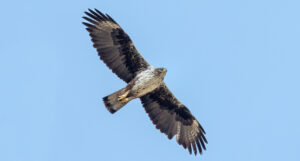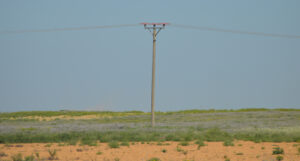Third International Scientific and Practical Conference “Eagles of the Palearctic: Study and Conservation”
Raptors Conservation. Suppl. 2. Proceedings of Conferences
Pulling the Plug on Eagle Electrocution in Israel: High-resolution Modelling of Bonelli’s Eagle Electrocution Risk
Mayrose A. (Department of Evolutionary and Environmental Biology and Institute of Evolution, University of Haifa, Haifa, Israel)
Haviv E. (Department of Evolutionary and Environmental Biology and Institute of Evolution, University of Haifa; Israel Ornithological Center, the Society for the Protection of Nature in Israel, Haifa, Israel)
Hatzofe O., Neser W. (Science Division, Israel Nature and Parks Authority, Israel)
Troupin D. (Department of Evolutionary and Environmental Biology and Institute of Evolution, University of Haifa, Haifa, Israel)
Elroy M. (Environmental Regulation, Engineering Project Group, Israel Electric Corporation, Israel)
Sapir N. (Department of Evolutionary and Environmental Biology and Institute of Evolution, University of Haifa, Haifa, Israel)
Contact:
Asaf Mayrose asafmayrose96@gmail.com
Eli Haviv Eli.haviv2@gmail.com
Ohad Hatzofe ohad@npa.org.il
Walter Neser wneser@gmail.com
David Troupin davidtroupin@gmail.com
Michal Elroy michal.elroy@iec.co.il
Nir Sapir nirs@sci.haifa.ac.il
Recommended citation: Mayrose A., Haviv E., Hatzofe O., Neser W., Troupin D., Elroy M., Sapir N. Pulling the Plug on Eagle Electrocution in Israel: High-resolution Modelling of Bonelli’s Eagle Electrocution Risk. – Raptors Conservation. 2023. S2: 370–373. DOI: 10.19074/1814-8654-2023-2-370-373 URL: http://rrrcn.ru/en/archives/35144
The Bonelli’s Eagle (Aquila fasciata) is a critically endangered species in Israel, with electrocution on power lines posing a serious threat on its population. Since insulation of electricity pylons is a slow and costly process, it is important to prioritize the insulation of the pylons in the network for quick and efficient mitigation of eagle mortality.
To determine which pylons need to be retrofitted, we applied a three-stage Maximum Entropy Modeling process for identifying the risk factors among different environmental variables.
The results show that the environmental feature with the highest correlation to electrocution events is the distance to water reservoirs, which are foraging hotspots of the eagles in Israel’s arid environment. Unfortunately, the only tall perch available for eagles in the vicinity of many of the reservoirs are the electricity pylons that power the reservoirs’ pumping facilities. This combination of anthropogenic alterations has apparently created a detrimental ecological trap.
The strong attractiveness of water reservoirs for the eagles may explain the high level of selectivity that was calculated by the model, suggesting that retrofitting only 3.6% of the pylons in the network would achieve 77% reduction in eagles’ electrocution probability. Moreover, insulating pylons according to the model is expected to achieve a significant remedy for other avian species, among them the Eastern Imperial Eagles (Aquila heliaca) and White-Tailed Eagles (Haliaeetus albicilla).
Synthesis and applications: The modeling process presented here yielded two electrocution risk maps, one of which is expected to facilitate properly prioritized mitigation of eagle electrocution in the existing power network of Israel, while the second map is designed to support an informed planning of new infrastructures. Applying this approach is expected to substantially aid the conservation of the population and allow it to recover to its initial size, which was three times its current size, about 70 years ago. The work presented here aims to prioritize the mitigation of raptor electrocution in arid and semi-arid areas, geographic zones that are largely under-studied in relation to this mortality factor. Electrocution in arid areas is of a particular concern in many developing countries, where networks of distribution lines are rapidly growing and raptor electrocution rate is high. The modeling approach presented in this study can be applied in these arid developing countries to mitigate raptor electrocution, aiding their conservation.


